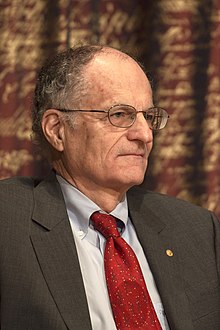Thomas J. Sargent | |
|---|---|
 Sargent in 2011 | |
| Born | July 19, 1943 Pasadena, California, U.S. |
| Education | University of California, Berkeley (BA) Harvard University (PhD) |
| Academic career | |
| Field | Macroeconomics, monetary economics |
| Institution | Hoover Institution Carnegie-Mellon University University of Pennsylvania University of Minnesota University of Chicago Stanford University New York University Peking University HSBC Business School |
| Doctoral advisor | John R. Meyer |
| Doctoral students | Robert Litterman Monika Piazzesi Mariacristina De Nardi Ellen McGrattan Lars Peter Hansen Albert Marcet Noah Williams Laura Veldkamp Richard Clarida Danny Quah Sagiri Kitao Martin Eichenbaum Lawrence J. Christiano Greg Kaplan |
| Influences | John F. Muth Robert E. Lucas, Jr. Christopher A. Sims Neil Wallace |
| Awards | Nemmers Prize in Economics (1996) NAS Award for Scientific Reviewing (2011) Nobel Memorial Prize in Economic Sciences (2011) |
| Information at IDEAS / RePEc | |
| Academic background | |
| Thesis | The structure of interest rates (1968) |
Thomas J. Sargent | |
|---|---|
| Allegiance | |
| Service | |
| Years of service | 1968-1969 |
| Rank | |
| Part of a series on |
| Macroeconomics |
|---|
 |
Thomas John Sargent (born July 19, 1943) is an American economist and the W.R. Berkley Professor of Economics and Business at New York University.[2] He specializes in the fields of macroeconomics, monetary economics, and time series econometrics. As of 2020, he ranks as the 29th most cited economist in the world.[3] He was awarded the Nobel Memorial Prize in Economics in 2011 together with Christopher A. Sims for their "empirical research on cause and effect in the macroeconomy".[4]
- ^ "NYU Bio: Thomas J. Sargent". NYU Stern. Retrieved 11 November 2022.
- ^ "NYU Bio: Thomas J. Sargent". NYU Stern. Retrieved 11 November 2022.
- ^ "Economist Rankings at IDEAS". Ideas.repec.org. Retrieved 2011-10-10.
- ^ "The Sveriges Riksbank Prize in Economic Sciences in Memory of Alfred Nobel 2011" (Press release). Nobel Prize. 10 October 2011.